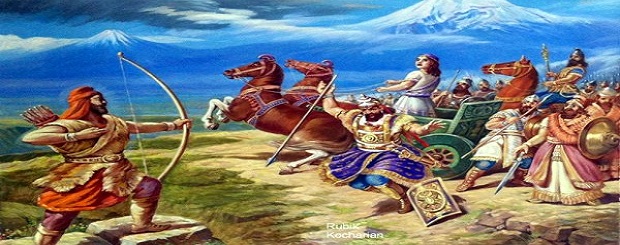
Are Armenians a biblical people?
Material provided by Alexander Bakulin
Sunday, December 8, 2019
After all, the Greeks, who are also mentioned in the Bible, do not call themselves the biblical people. These are the people of Homer, Plato and Aristotle. In the case of the Armenians, their connection to the Bible has a dual origin. Armenians, on the other hand, are also pre-biblical people.
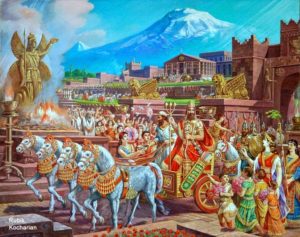
Moreover, the Armenians, apparently, are the only living people whose language has retained the meanings and meanings of the dead Sumer, Mesopotamia, Egypt cultures and can serve as a bridge to understand the experience and values of these ancient cultures.
Apparently, only this language, as modern as it is ancient (what is its value!), Allows us to link the development of human culture in one continuous chain and to show its continuity and unity, despite the devastating destruction.
On the other hand, as indicated by the authoritative sources cited below, a substantial portion of the content of the Bible was borrowed by ancient Jews (genus-type armenoids) from Proto-Armenians who lived in vast regions of Asia Minor and even Palestine, before the arrival of the ancient Jews. We will unveil these theses in more detail.
Before the formation of biblical texts, Armenians already had a rich and glorious history, had their own religion and political organizations, and were an influential people in the whole gamut from Egypt to Afghanistan.
Let’s try to delve deeper into the pre-Biblical history of the Armenians, relying solely on excerpts from two books (1.Karpichechi AK Art and History of Egypt, Florence, 2000, 2.Robak K.Antiquity, New York. 1966).

There are many publications on the history of the ancient Armenian kingdom of Mitanni, including Russian. There are far fewer references to this state’s foreign policy relations.
As the first of the books quoted indicates, “the intense links of the state of Mitanni with ancient Egypt in the sixteenth century BC. revolutionized the culture of the Egyptians.
The war against the Hyksos Amenofis I (1546-26) and Thutmose I (1526-12) led to the first clashes with the Mitannians. The victories of the Egyptian Pharaoh Thutmose III (1505-1450) in the battles with the Mitannians, – in addition, in 1483 BC.
Tuthmosis III crushes them on the territory of Mitanni – transformed into a triumph of the Mitannian culture in Egypt itself.
The most famous pharaoh of ancient Egypt, Thutmose III, was distinguished by his generosity, forgiving the rebels and preserving the customs and religious traditions of the conquered territories.
Similar image
His son Amenophis II (1450-1425) makes peace with Mitanni, marries his son, the future Pharaoh Thutmosis IV (1425-1408), on Princess Mitenia, daughter of the king of Titanic Artatam “(1, p.10).
Son of Thutmose IV, already an Armenian mother (in ancient Egypt, sex and inheritance were determined by the maternal lineage), Amenophis III (1408-1372) maintains peace with neighboring states by marrying their princesses – Tiu (Tuyya), daughter of the Mitannian king Sutarn, and on the daughter of the Babylonian king Kalimasin.
“Tiu has a strong influence on Pharaoh” (1, 11). “Under Amenophis III, Egypt reaches the peak of its power and prosperity.
The relations of Amonophis III with Tushratta, the king of Mitanni, were particularly cordial “(2: 82). The son of Amenophis and Tiu, “this indomitable main wife of the Pharaoh”, 3/4 Armenian, Amenophis IV (1372-1354), who entered history under the name of revolutionary pharaoh, “heretical pharaoh” Akhenaton, also takes the Mitannian princess as wife.
After a short marriage (4 years) and the death of the princess, he married his sister Nefertiti, “the most beautiful woman”.
Nefertiti has an exceptional impact on the religious life of the Egyptians: it erects the new God Aton, symbolizing the solar disk.
Akhenaton not only changes his name, but also replaces the traditional Egyptian religion of Amon with the Meenanian, monotheistic and profoundly mystical religion of Aton, according to which all men are equal in love for one God, whose Pharaoh is the Prophet.
The new God was devoid of the zoomorphic and anthropomorphic characteristics inherent to the Egyptian gods. New was also the focus on Aton’s role as creator and benefactor of the universe. In addition to Aton, only Akhenaton existed gods.
Pharaoh shared the divinity of Aton and spoke of him as Aton’s son and co-regent. In the center of Egypt, he creates a new capital – the city of Ahetaton, “the horizon of Aton”, where the religious authority also moves from Thebes.
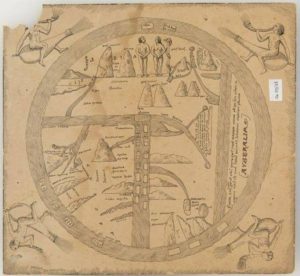
(In fact, it seems that Aton’s service began in the previous generation, with the advent of Tiu and was based on the deep roots linking these cultures to the common worship of the Sun God Ra, in honor of which the city of Heliopolis was built in Egypt).
Akhenaten dies in 1354 BC The throne is inherited by the legendary pharaoh Tutankhamun (1354-1345), who marries one of the six daughters of Akhenaten, reigns in Egypt for seven years under the regency of Nefertiti, then mysteriously dies. 18 years old.
His desperate young wife asks for the help of the powerful Hittite king Shapilalumash (1380-35), whose wife was one of the Nefertiti sisters, asking her to send one of her sons as her husband, apparently trying to support his reigns in an alliance with the Hittites.
Shapilalumash, suspecting a trap first, then he is convinced of the sincerity of the request and sends the young prince to marry the princess.
However, the prince disappears on the way, presumably, killed by one of Ey’s agents, an influential priest who did not want to lose power. Nefertiti, who married the old priest Eij, manages to maintain power for another 4 years.
But with her death, the city of Ahetaton is destroyed, and with it the memory of the beautiful queen, and even the place of her burial. Egypt falls into anarchy and poverty.
Since the Princess’s movement was usually accompanied by a magnificent procession of hundreds, if not thousands, of courtiers, servants, priests, warriors, performers, the influence of the Mitanni culture on Egypt lasted nearly a hundred years. years.
However, the concepts associated with Aton were too abstract, complex and incomprehensible for the perception of ordinary Egyptians, who preferred to return to their usual gods. It must be said that relations with the Hittites were not less narrow.
For example, the pantheon of gods and dignitaries buried in the tomb of Yazylkay (Turkey), a sacred place for the Hittites, is fully represented by the Proto-Armenians (perhaps the Mitannians) and their gods, not the Hittites.
It is believed that this gathering of foreign gods was initiated by Queen Padahepa, an Armenian princess who became the wife of the Hittite King Hatushilish III. We also know that she was in correspondence with her sister, the next Egyptian queen of Armenian origin, the wife of Ramses II (1298-1235) about the Hittite peace treaty with Egypt (2 96).
As the author of the second monograph indicates later, the Hittites borrowed most of their mythology from the Armenians and even transferred some of these stories to the ancient Greeks.
For example, a series of stories about Kumarbi, the father of the gods who conquered his kingdom in the fight against competitors, where are the stories about Zeus found in Theogony, a work of the Greek poet Hesiod, who lived in the seventh century Before Christ.
Another story about the Kumarbi Wars is the “Allikam Story,” containing elements similar to the ancient Greek myth of Typhoon, who fought with Zeus. The primitive art of ancient Greece was also directly influenced by the Urartu Armenians, through whom the oriental flavor entered.
Regarding the links between the ancient Jews and the ancient Armenians, this author (2) indicates that the contacts with Mesopotamia explain the parallels between the laws of the patriarchs of the Jews and the laws of Hammurabi (Babylon), and the stories of floods made part of the traditions of this region.
However, “these Jews could borrow laws and stories from the Armenian population of Palestine, who lived there before the Jews appeared” (2, 127). In this brief historical information, one feels the tension of the old Armenian foreign policy activity, its active ideological influence on neighboring countries.
What was the content of this pre-Biblical Proto-Armenian culture, now extinct? It would be interesting to follow the ancient Armenian in his search for the truth, full of doubts and torments, but illuminated by the ecstasy of faith, because the man himself has tried to find the meaning of reality, to understand why and why his own life and all the surrounding universe have been given.
The fact that the truth was found independently and not borrowed from neighboring peoples can explain the strength of faith and its inseparability from the actions of ancient Armenians, who manifested themselves even in the intensity of their influence over other peoples.
Each nation, having left its source in prehistoric times, then moves like a river: there may be turns, rapids, the speed of the stream to slow down or accelerate, but it is a necessary and unidirectional movement – the rivers do not flow back.
Will not we find that the spiritual problems of the ancient Armenians were very close to ours? Or, on the contrary, that we have nothing to do with our old culture? Let’s try to restore some elements of their culture in his Egyptian footprints.
The basis of the whole system of religious thought and strict morality of the Egyptian people is found in the myth of Osiris, which reflects not only historical events, but is also a highly spiritual concept.
Over the centuries, it has gradually become obscured and obscured by a mass of accumulated details and contradictory episodes, but, despite this, its enormous ethical and religious significance is still evident even for our modern mentality, petrified for millennia of civilization .
The great myth of Osiris can be stated in a few words, simply and clearly. After the three divine kingdoms, in which the gods Shu, Ra and Geb, replacing each other, patronized humanity in paradise, the time had come for Osiris and his mission.
Absolute Spirit has been incarnated in man to reach humanity, lost out of Paradise and, as a man, he has suffered and died with other people. He became a man to lead his own kind along the road hard to understand his purpose, to make people creators of their own lives,
He has become a man to die like the last of men, the victim of the most serious injustices. Dismembered by his own brother and resurrected, he gives confidence in the rebirth of eternal life, thanks to the boundless love that links creation to the Creator.
It is the proof of love and resurrection, as the main essence of all that has been created; the testimony rendered directly by the act of creation itself: the Sun, disappearing and reborn every day again, always; a seed that dies in the dark bowels of the earth and reborn, flourishes abundantly under the rays of the sun and gives new life every year, always.
This certainty is the same force that, after several centuries, will lead Socrates to clearly realized suicide, the same force that, combined with morality and spirituality, has penetrated Greek myths and Roman cults.
The deep love that permeates the myth of Osiris has surrounded the figure of Isis, the goddess closest to the Egyptian people, the most human and passionate creature ever appeared in the ancient world, with mercy and tenderness.
We will meet temples and statues dedicated to him throughout the Roman Empire, and today you can still see the ruins of the small temple of Isis in Pompeii, built in the first century AD.
If Osiris perceives the meaning and experience of the resurrection inherent in the forces of nature, then Isis is trust, a guarantee of rebirth, the final victory over evil and death.
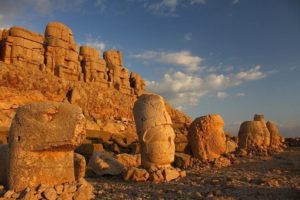
In the third millennium, the clear and crystalline essence of the myth of love and resurrection became foggy, because it became an instrument of power in the hands of the caste of more or less enlightened priests, but a miracle is produced in the second half of the third millennium.
It did not last long, but left a deep mark in human thought. This miracle was expressed in the attempt of Akhenaton (1372-1354 BC) to transform the occult religion into a religion for all, with a clear image of a unique and absolute god.
In an atmosphere of agitation and uncertainty, a short period of Akhenaten begins, with his religion of equality, love and direct connection with God, bringing to all faith in universal salvation.
The universe is synthesized into a single act of love, connecting the Creator and the Creation, because “You are the only one, only You create thousands and thousands of beings … You are the flow of life, and no one can live without you …
You live in every baby from birth in the morning of your mother, You empty his tears, You open his mouth and drive him as long as he needs it … You are the God of all, You are the one who cares about all.
You, who create the life of all nations, have placed the Nile in the sky, so that it may come down to us and wash our fields with its waters and fertilize them. ”
This love, which creates and exalts the entire universe, manifests itself continually among us, for it is like the ray of the sun, from which heat comes, giving life, it is like an endless hand full of gifts.
The Pharaoh himself, the prophet of the absolute God, and all his family generously transmit the divine gifts to the people.
The rite of thanksgiving and the offering of Pharaoh’s gifts to Aton-Ra take place openly, in the rays of the Sun, on the multitude of altars, where services are rendered by all, surrounding the altar of Akhenaten.
This image of Pharaoh and his family lived only during his life. Despite the enthusiasm and support of his friends, with the death of this great husband, the old caste of priests took power, cursing the “heretic pharaoh”.
The temples of Aton were destroyed, the followers of Pharaoh were persecuted for the overthrown religion, and Ahetaton, the holy city, was abandoned in the desert.
Amon returns with all his crowd of gods, the art takes the traditional direction, but the brief experience of Aton was not vain.
The great mystical discovery has left deep traces, giving birth to a spark that has erupted in the lives and religions of other peoples, even cleansing the traditional faith.
Indeed, in recent centuries, despite various invasions and foreign dominations, Amon-Ra has become one who “can not be represented by anything, for he is a pure spirit,” and in the daily rite of “the offering by the hands of the priest “, the offerings began fundamentally, spiritually, reduced to a symbolic statuette of Maat:” flesh, soul, food, breath of life “of the Creator.
The secrets of Osiris were perceived in Greece and Asia Minor, the Egyptian cosmogonic representations were developed by Thales and Pythagoras.
Akhenaten’s religious experiences and pantheism of love have penetrated everywhere, even in completely different worldviews like Greek and Jewish.
Six centuries later, at the time of Sais (666-524 BC), the high spirituality of the Egyptians will be reborn in the individual consciousness, in the equality of persons before God and in the renewed faith in God. Divine Providence.
These will be the last echoes of the ancient religious power, the instigator of the strongest and brightest reflections in the worldview of the peoples that form around Egypt – in Greece and Palestine.
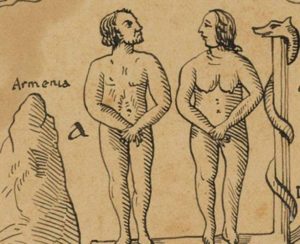
The influence of the Mitannian culture and religion, which has been facilitated by Akhenaton and previous generations of his relatives, is in its socio-cultural sense equivalent to the spirit of Protestantism that swept Europe in the 16th and 17th centuries.
As three millennia earlier, bringing man closer to God, European Protestantism proclaimed its communion with God without the mediation of the church.
Of course, since the goal of the influence of the Mitannian rulers was a foreign policy action, as a rule, aimed at establishing control of the adjacent territory, it certainly had to be directed against a layer of priests – the theocratic rulers ‘Egypt.
But, despite the pragmatic side of this cultural action, the wisdom of ancient peoples remains eternally relevant today.
As we see, the cornerstones of human virtue are an integral part of the same ideals that, three thousand years later, became the basis of Christ’s preaching on the kingdom of heaven. By the way, much later, in the Kandahar region, Tamerlan has resettled 10,000 Armenians from Karabakh.
Article author: Ernest Grigoryan. Material provided by Alexander Bakulin
ORIGINE SOURCES-nashaarmenia.info/2019/12/08/являются-ли-армяне-библейским-народо/
ENGLISH TRANSLATION “lousavor avedis“
